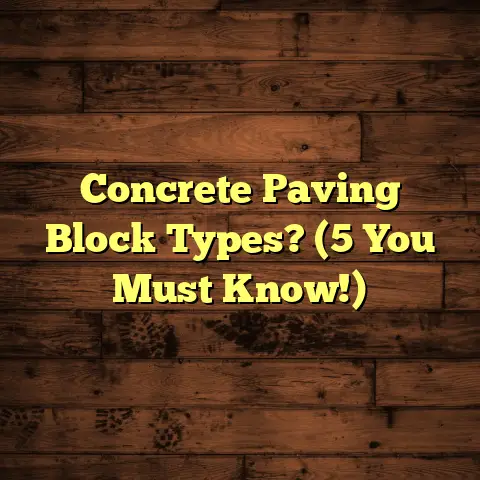New House Floors Creak? (7 Reasons Why!)
Have you ever stepped onto your brand-new hardwood floor only to be greeted by an unexpected creak that shatters the tranquility of your new home?
It’s a common issue, and trust me, you’re
not alone!
As a flooring contractor, I’ve
seen this countless times.
Let’s dive into
why your brand new floors might be singing
a creaky tune.
1. Understanding the Phenomenon of
Creaking Floors
Creaking floors can be a real source of
annoyance for homeowners.
It’s that
unwanted sound that seems to echo through
your home, especially when you’re trying
to enjoy some peace and quiet.
Many people think creaking floors are only
a problem in older homes, but that’s a
misconception.
New homes can also
experience this issue, and there are several
reasons why.
2. Reason #1: Natural Settling of the House
New houses are like us after a big meal – they settle!
When a new home is built, the ground
underneath gradually compacts.
This settling
process can cause slight shifts in the
structure, which in turn, can lead to floors
creaking.
Think of it like this: your house is finding its equilibrium.
The timeline for settling varies, but it
typically occurs within the first few years
after construction.
Different materials react
differently during this phase.
For example, wood framing might shrink slightly
as it dries, while concrete foundations can
settle and crack.
These movements can put
stress on the flooring, resulting in those
annoying creaks.
I’ve seen settling issues more pronounced
in areas with expansive clay soils.
According
to the American Society of Civil Engineers
(ASCE), expansive soils can swell and shrink
significantly with changes in moisture content,
exacerbating the settling process.
3. Reason #2: Humidity and Temperature Changes
Ah, the weather! It affects everything, including your floors.
Fluctuations in humidity and temperature can
cause flooring materials, particularly wood, to
expand and contract.
This movement can lead
to friction between the floorboards and the
subfloor, resulting in creaky sounds.
Wood is hygroscopic, meaning it absorbs and
releases moisture from the air.
During humid
months, wood expands as it absorbs moisture.
Conversely, during dry months, it contracts
as it releases moisture.
I remember one instance where a homeowner
complained about severe creaking during the
winter months.
After inspecting the home, I
found that the relative humidity was extremely
low, causing the wood floors to shrink
significantly.
Using a humidifier helped stabilize the moisture levels and reduce the creaking.
According to the Forest Products Laboratory, maintaining a relative humidity level between 30% and 50% is ideal for minimizing wood movement.
4. Reason #3: Poor Installation Practices
This is a big one, folks!
Proper installation is crucial for preventing
creaking floors.
Even the best materials can
creak if they’re not installed correctly.
Misalignment, inadequate fastening, or improper nailing can all lead to creaking floors, even in new homes.
Think of it like building a house of cards – if one card is out of place, the whole structure is unstable.
Here are a few common installation mistakes I’ve seen:
- Insufficient Fasteners: Not using enough nails or screws to secure the flooring to the subfloor.
- Improper Spacing: Leaving too much or too little space between floorboards.
- Misaligned Boards: Installing boards that are not perfectly aligned, causing them to rub against each other.
- Using the Wrong Fasteners: Using fasteners that are not designed for the specific type of flooring.
I once had a client who hired a budget
contractor to install hardwood floors.
The
contractor used insufficient nails and left
inconsistent gaps between the boards.
Within
months, the floors were creaking like an old
pirate ship!
Redoing the installation with proper techniques resolved the issue.
5. Reason #4: Inadequate Subflooring
The subfloor is the foundation of your floor.
If it’s not solid, your floors will suffer.
The subfloor provides a stable base for the
flooring material.
Issues such as improper
thickness, insufficient support, or uneven
surfaces can lead to noise and movement in
the flooring above.
Think of the subfloor as the foundation of a
house.
If the foundation is weak, the house
will be unstable.
Common subfloor problems include:
- Insufficient Thickness: Using a subfloor that is too thin for the span between joists.
- Uneven Surface: Having an uneven or warped subfloor surface.
- Inadequate Support: Not having enough joists to support the weight of the flooring.
- Damaged Subfloor: Having a subfloor that is damaged by water or pests.
I remember one project where the subfloor was
significantly thinner than required by code.
As a result, the floors had excessive flex,
leading to constant creaking.
Replacing the subfloor with a thicker material provided the necessary support and eliminated the noise.
According to the APA – The Engineered Wood Association, the recommended subfloor thickness depends on the joist spacing and the type of flooring material.
6. Reason #5: Material Quality
You get what you pay for, right?
The quality of flooring materials significantly
impacts their performance and susceptibility
to creaking.
Cheaper materials are often more
prone to warping, cracking, and other issues
that can cause noise.
Let’s compare a couple of options:
- Engineered Wood vs.
Solid Hardwood: Engineered wood is generally more stable than solid hardwood because it’s constructed from multiple layers of wood.
This makes it less susceptible to expansion and contraction. - Laminate vs.
Vinyl: High-quality laminate and vinyl flooring can be very durable and resistant to moisture.
However, cheaper versions may be more prone to warping and delamination.
I once installed a high-end engineered hardwood
floor in a client’s home.
The material was
dimensionally stable and resistant to moisture,
resulting in a floor that was both beautiful
and quiet.
On the other hand, I’ve seen cheaper laminate floors that started creaking and buckling within a year due to poor material quality.
7. Reason #6: Structural Issues
Sometimes, the problem isn’t the floor itself, but the house!
Broader structural issues within the home can
contribute to floor noise.
Factors like
foundation problems, joist spacing, and
load-bearing considerations can all play a role.
Think of it like this: if the foundation of your house is unstable, the floors will inevitably suffer.
Here are some structural issues to consider:
- Foundation Problems: Settling or cracking in the foundation can cause the entire house to shift, putting stress on the floors.
- Joist Spacing: If the joists are spaced too far apart, the subfloor may flex excessively, leading to creaking.
- Load-Bearing Walls: If load-bearing walls are not properly supported, they can sag over time, causing the floors to become uneven.
I once inspected a home with significant
foundation issues.
The floors were creaking
throughout the house, and there were visible
cracks in the walls.
Addressing the foundation
problems was essential to stabilizing the
structure and reducing the floor noise.
8. Reason #7: Foot Traffic and Usage Patterns
Last but not least, how you use your home matters!
The way the home is used can lead to noise
from the floors.
Heavy furniture, frequent
movement, and specific activities (like
children playing) can all impact floor creaking.
Think of it like this: your floors are designed to withstand normal wear and tear, but excessive stress can take its toll.
Here are some usage patterns to consider:
- Heavy Furniture: Placing heavy furniture on areas of the floor that are not adequately supported can cause them to flex and creak.
- Frequent Movement: Constant walking or running on the floors can loosen fasteners and cause boards to rub against each other.
- Specific Activities: Activities like dancing or exercising can put extra stress on the floors.
I had a client who complained about creaking
floors in their children’s playroom.
After
observing the children playing, I realized that
their energetic activities were contributing to
the noise.
Adding rugs and reinforcing the subfloor in that area helped reduce the creaking.
Conclusion
So, there you have it – seven reasons why your new house floors might be creaking!
While creaking floors in new homes can be concerning, understanding the root causes can help you feel more at ease.
Take a look around your home, consider these factors, and remember, I’m always here to help if you need a professional opinion!





